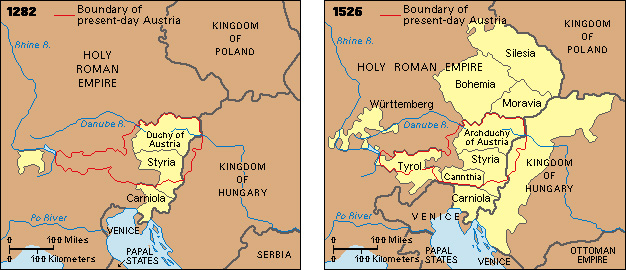Holy Roman Empire was a German-based empire in western and central Europe that began in A.D. 962 and lasted until 1806. Initially, it was closely associated with the Roman Catholic Church. But disputes between the emperors and the popes reduced the influence of both. Members of the powerful Habsburg (also spelled Hapsburg) family ruled for most of the empire’s last 400 years.

Some scholars trace the origins of the Holy Roman Empire to an empire founded by the great ruler Charlemagne. Charlemagne’s empire included most of what is now France, Germany, and Italy. In A.D. 800, Pope Leo III crowned Charlemagne emperor of the Romans. But the empire fell apart after Charlemagne died in 814.
In the mid-900’s, King Otto I of Germany gained control of most of northern and central Italy. In 962, Otto had Pope John XII crown him emperor of what became known during the 1200’s as the Holy Roman Empire of the German Nation.
Problems of the empire.
From the start, the empire faced serious problems. The emperor’s authority was often challenged by powerful German nobles and unfriendly popes. The emperor’s difficulties were made worse because he was chosen by election. Until the mid-1400’s, strong nobles often disputed the election results, and these challenges sometimes led to civil war. Before 1500, the great size of the empire also made it difficult for the emperors to rule it effectively.

Problems with the popes began in the mid-1000’s, when Holy Roman Emperor Henry IV and Pope Gregory VII tried to establish authority over each other. Popes and the emperors fought for authority until 1250, when Pope Innocent IV and the Italian city-states gained almost complete independence from the empire.
The German nobles gained power during the struggle between the emperors and the popes. They were particularly powerful during the period from 1250 to 1273. In this period, called the Interregnum, there was no emperor at all. After elections for emperor resumed, the nobles chose an almost continuous succession of weak rulers for about 150 years.
The House of Habsburg.
Albert II of the Habsburg family became Holy Roman emperor in 1438. The Habsburgs ruled from then to 1740 and again from 1745 to 1806. Many institutions of the empire took their final shape during the early years of the Habsburg period. They included a legislative body, courts, and a military system.

In the first half of the 1500’s, the empire was headed by Charles V, the most powerful European ruler since Charlemagne. But Charles V eventually lost much of his power, in part because of the Protestant Reformation, which split Germany into rival Protestant and Roman Catholic groups.
Habsburg power declined further as a result of losses in the Thirty Years’ War (1618-1648) and the rise of the powerful German state of Prussia in the 1700’s. Defeat by French armies during and after the French Revolution (1789-1799) further weakened Habsburg power. In 1806, after France defeated the Habsburgs, Emperor Francis II declared the end of the Holy Roman Empire.
